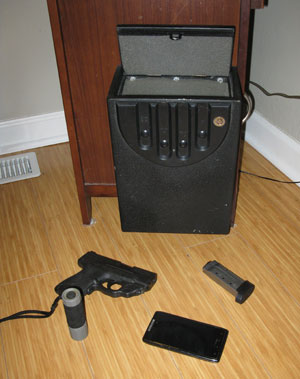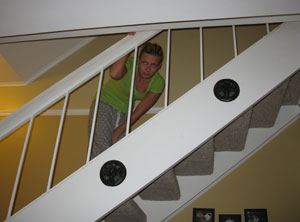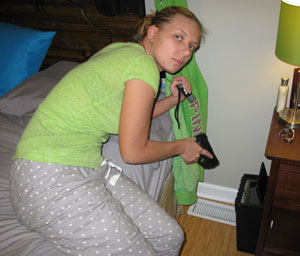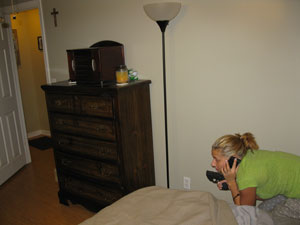
As a law enforcement officer, I have a front-row seat for watching crime trends grow or decline. I use that experience to my advantage as a firearms trainer for both law enforcement and the private citizen.
HOME INVASION
An area of increasing concern is the occupied home invasion, which can be defined as an incident where the house is occupied by the family or owner and they are confronted with an imminent and potentially lethal threat by an intruder(s). In recent years, the occurrence of these violent encounters inside the home has been increasing, as has media coverage of their outcomes.
This growing concern has prompted a surge of new gun owners who intend to keep that newly purchased firearm for the primary purpose of home defense. There is a void in the training industry regarding this type of incident, at least in the proper context.

HOME DEFENSE TRAINING
As with any of the training courses we attend (unless attending for fun), we want to ensure it fits our context of use. Though there are many “tactical” training courses out there that proclaim to train students in the art of safe rooms, room clearing and building searches, these are concepts that take many more hours and teammates to execute properly than can be taught in a course that lasts just a few days.
As a certified Defensive Firearms Coach, I teach I.C.E. Training Company’s Introduction to Defensive Handguns. That course includes what we refer to as the Five Fundamentals of Home Defense. These fundamentals provide a solid foundation for the new firearm owner and keep the context realistic to the perceived threat we are there to train for.
The five fundamentals of home defense are Evade, Arm, Barricade, Contact and Counter. Let’s break those down.
Fundamental Home Self Defense Skills:

Ashley evades to safe room, taking a quick look to see if she can get a description of the intruder.
EVADE
Avoid the potential impending threat
Though this is a common-sense approach to anything that can cause us harm, we define it early. If we can avoid the threat, avoid it. This includes ensuring our alarm systems are working, windows and doors are always secure, and the dog makes noise when strange people come around.
If we can escape, escape and get out. We all know the common sounds of our house and all the ways to get out if we need to. Should we believe there is the potential of a home invasion and we have the opportunity to leave the house, do it and deal with the potential threat from an external location by whatever means necessary. I fully recognize there may be other variables that prevent us from leaving the house during an incident like this. Kids or elderly parents could be in other parts of the home, and as the caregiver we would not want to leave them behind. This is where the second fundamental comes in.
ARM
Arm yourself with a defensive firearm.
In the event we are unable to escape, it may be time to arm ourselves with the firearm we keep in the house for defensive purposes. This brings up many questions for the new gun owner. Two of the most-asked questions are: How do I store my firearm? Where do I store it?
I caution giving standard answers, because it all depends on the individual’s living arrangements. The answers for a family with children may be different than for a single person living alone. But I do recommend a quick-access safe. It should be placed in an area accessible from where most of the time in the house is spent. The contents of the safe should be a quality defensive firearm with an extra magazine or speed loader, and a quality light source. I recommend a stand-alone light, not a weapon-mounted light. We may want to illuminate things we prefer not to point a firearm at. The light should be equipped with a lanyard so it is not dropped should we need to use our support hand for other tasks. The key item often missed by many is a phone. This can be our cell phone grabbed from the nightstand or even an old cell phone. We’ll talk more about that later. Once we arm ourselves, we move to the next concept.
BARRICADE
Barricade 90 degrees from the direction of movement or attack.
When you consider your barricade location, you may choose to keep your firearm there. I do not advocate moving with a firearm exposed. When we position ourselves, it is imperative we remain 90 degrees from the direction of attack. That gives us the greatest opportunity to act before being observed by the threat. The barricade location should be the farthest point that allows us to engage the threat with our firearm beyond two arms’ reach and at full extension. The only caveat to the above would be if there were a strong piece of cover located in the room.
Once in our barricade position, we move to the next phase.

CONTACT
Contact the authorities.
Contact armed professionals as quickly as possible. They are far better equipped to deal with a home invader than we are alone. By offering them the appropriate information, we can make their response that much more efficient. Remember that if we call from a cell phone, the location may not be immediately available to the 911 operator. I advocate conveying these five pieces of information when possible:
- Where – Where are you? The physical address and your location within the house are essential. You can convey the intruder’s location if you know it. If able, it’s also helpful to provide first responders with a way into the house or route information to your location inside.
- What – What is happening? E.g., you have a home invader and they are in or trying to get into the house.
- Armed – The fact that you are armed is important information to tell the operator.
- Your Description – What you look like and are wearing, as well as descriptions of anyone else who may be in the home and did not make it to the barricade location.
- Intruder Description – If you have any identifying information about the intruder, it can be very valuable to responding professionals. You may have gotten a good look at the intruder and can provide a full description. You may only be able to say the intruder was male and short. Any information will be helpful, but under no circumstances should you wait around to get a description before trying to evade.
COUNTER
Counter the threat when presented.
This step has an unlimited number of possibilities. You might need to engage the threat with your firearm. Or the threat may see you with your firearm and flee. Every situation is going to be different. I do not advocate announcing yourself blindly and telling the intruder you are armed. To a motivated intruder, this only gives away your location. The exception here is if they are entering the room where you are located, it may be an option. The best-case scenario is that armed professionals arrive on the scene prior to the Counter phase, but we cannot count on that outcome and must be prepared to act accordingly.
CONCLUSION
These five fundamentals of home defense are the foundation for creating your home defense plan in the event an intruder attempts or actually makes entry into your home. Of course we could spend much more time breaking down each category and the included information. If you think this information is valuable to your home defense plan or a topic you would like to learn more about as a new firearm owner, check out one of the Introduction to Handguns or firearm training courses being offered by a certified Defensive Firearms Coach in your area.


I think one thing that is overlooked is that if you shoot a gun in a building, it will ruin your hearing and getting off a second shot may be very hard I would think. Those conversation amplifying loud noise canceling earbuds or ear muffs would be worthwhile having near your gun. Having the time to put them on is the trick. I cannot imagine a 12 gauge going off in a house and the ear drum damaging noise. The same goes for shooting from a vehicle. Your hearing would be shot for good it would seem?
Thank you.
Good information, The more we read And learn about tactics the better we can prepare. Thank you.
Weapon at the ready, and not retreating. Why would I put myself outside not knowing what threat awaits? I wouldn't. I would deal with the known threat. And remember, when seconds count, Johnny Law is only minutes away. Plus, they usually are only around to make reports, not to defend you in your home. That's your job. If you don't have an alarm, dogs are excellent and better than people at first detection - get one if you are worried about armed home invasion.
I would argue that you should be armed at all times. Getting to your firearm may not be possible. If your firearm is not on you, why would you exit the building without the firearm, leaving it for the criminals? Get your firearm, before escaping, so that if you encounter other criminals outside, you have protection.
The ultimate quondry here at what point do you use your weapon in self defense?
Can you recommend a Defensive Firearms Coach inthe Brandon, Fl. 33594 area?
I'm sorry, but Flee your home, if intruders break in is the worst advice that I have ever heard. You are never so vulnerable as when your back is turned. Defensive firearm in a safe? the young lady in the photo will be having her jammies yanked down before she can access a a weapon in a safe. How about a deadbold with inside thumb bolt on the bedroom door, to slow an intruder down, until you can get to a safe room or access a weapon. Your advice will get folks hurt!
Great article, with some helpful information to think about. Thanks
I am a certified NRA instruck or with over 25 years of firearms experience and various training. I don't know if I agree with the part of nor anouncing yourself that you are armed and willing to defend yourself if necessary? It let's the intruder also have a chance to disengage without being surprised by the armed homeowner and starring a close quarters fire fight. This also helps you legally in cases where it is necessary to retreat in that you have given the intruder the opportunity to just leave. The NRA teaches thus methodology in their PPIH CPL course. I can see your viewpoint, but whatever method is chosen you train it the same way every time. Thanks. Dave